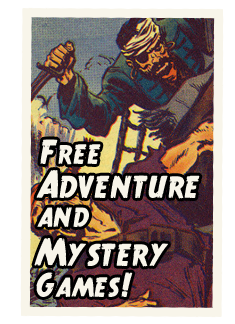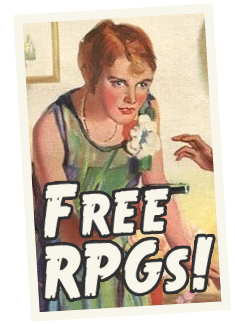CHARACTER CREATION
Each character has four stats. What these are should be customized to suit the exact tone or genre of horror being emulated, but each should have a very distinct use and flavor. Coming up with what stats you want in your session is a fun activity that gets the whole group on the same page. Characters start with one point in each and get four more points to assign however they wish.
EXAMPLE ONE: GOTHIC HORROR
Character: Mariah Saunders
PIETY [1] (Used for resisting spiritual influence and keeping one’s composure)
HEALTH [2] (Used for physical checks of all sorts)
SCHOLARSHIP [3] (Used for general knowledge)
PERSPICACITY [2] (Used for detecting things)
EXAMPLE TWO: SLASHER FLICK
Character: Chuck Sexton
GUTS: [3] (Used for daring aggressive action, like attacking with improvised weapon)
NERVE: [1] (Used for urgent precise action, like starting a car)
INTUITION: [1] (Used for noticing something’s wrong or navigating supernatural rituals)
LUCK: [3] (Used for random crapshoots)
CONFLICT RESOLUTION
Only challenges which are covered by the four stats are important or resolved with the dice. The GM is otherwise welcome to decide between incidental success or non-critical failure.
When a character tries to do something important, ie, that is covered by the four stats, they roll as many dice as they have points in the stat. Dice which come up fours, fives, and sixes are “successes.” Rolling even one success is usually enough, but if something’s outrageously hard or runs counter to genre expectations, you might need as many as two to pull it off.
EXAMPLE ONE:
Mariah attempts to research the catacombs of Paris, a straightforward and reasonable thing to do. She rolls her three points in SCHOLARSHIP: 1, 4, 6. That’s two successes, which is more than enough to complete her research.
EXAMPLE TWO:
Chuck tries to put the mute slasher in a headlock; very improbable for the genre. He rolls his three points in GUTS: 1, 3, 5. That’s one success, but because this is wicked hard, he doesn’t make it. If it had been a NERVE check, he wouldn’t even have had enough dice to succeed.
THE EVIL
“The Evil” is a general-purpose term for the scary natural or supernatural force the players are up against. The Evil could be wicked spirits, zombie hordes, machete-wielding maniacs, or anything else that’s appropriate, but The Evil always:
- Is capable of striking without warning
- Is capable of striking with a horrifying amount of warning
- Wants the party to suffer
The Evil represents the only mechanical threat in the game. Unless it is present and acting, players can at most be trapped, separated, scuffed up, spooked, or inconvenienced by failed rolls.
Mechanically, The Evil works as follows:
The GM begins with eight Evil Points per player.
When a player rolls for conflict resolution, the GM may spend one to four points of Evil to roll that many dice against the player. This represents The Evil choosing this moment to clash with the character, threatening to do them harm.
Sometimes the player will be totally aware this is going to happen—for example, if the player’s attacking the masked murderer with a coathanger, they can expect the GM to drop quite a few dice to represent the murderer fighting back. Sometimes, this is a nasty surprise for the players—for example, a player rolls to charge down a door and is unpleasantly surprised when the GM also rolls, announcing that a machete plunged through the mail slot.
If the GM rolled successes, those are bad news. Players can spend their own successes to cancel these out. (Obviously, if the player’s left with no successes, the check fails.)
GM successes that aren’t canceled cause the unfortunate character to lose that many points of whatever stat they were rolling due to injury, stress, madness, or some other appropriate consequence. If the stat is depleted, the player character is removed from the game. In a campaign a player may rest for an in-game period of time to replenish a stat, but the GM gains 4 Evil when they do so. They may also replace a character, but when this occurs the GM gains 8 Evil.
A session or campaign ends:
- When the players have accomplished their objective
- When The Evil is entirely depleted
- When all characters have been removed.
Whichever comes first.
EXAMPLE:
Chuck jumps into his hot rod and desperately tries to get it started: a NERVES check. As he rolls his one die, the GM unexpectedly rolls two: the slasher is in the rearview mirror, climbing out of the backseat with a machete!
Chuck rolls a 5; one success. The GM rolls a 2 and a 6; also one success. Chuck has no choice—allowing the success to stand would deplete his NERVES, killing his character. He blows his own success, meaning the car doesn’t start, but because he’s negated the GM success he manages to dodge the wild machete slash.
Chuck jumps out of the car and starts running, but which way is the cabin? It’s down to pure dumb LUCK. He picks up two dice, and is unsurprised when the GM picks up two as well: the slasher is in hot pursuit, after all.
Chuck rolls a 1 and a 6. The GM rolls a 3 and a 5. Chuck could negate the GM’s success by spending his own, but he’s not eager to remain out here in the woods. He keeps his 5. He’ll reach the cabin, but his LUCK is permanently down by one point: everyone’s luck runs out sooner or later, after all…
A QUICK TIP
If you’re GMing this game, feel free not to explain any of the mechanics after “Conflict Resolution.” Let them get used to rolling nice, safe checks on their own; let them wonder in the back of their head where the danger is. Then, when the danger shows up, don’t announce the new mechanics: just roll against them and watch the looks on their faces. When you roll your first success, that’s when you can incidentally mention the conditions for character death…
A NOT-SO-QUICK TIP
If you’re looking for advice on tablecraft and GM practices when running horror sessions, I’ve written a guide to some overlooked principles: HOWSCARUM.





